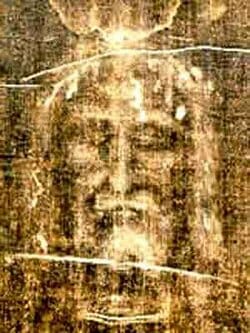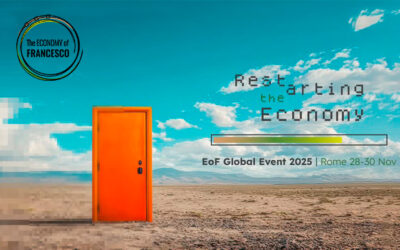 “The French magazine “Paris Match” published a long article on a very important object which can tell us something about the One we love. I read it quickly but it made a deep impression on me. During this year, since the Gen asked me, I have tried to speak about only one subject: Jesus crucified and forsaken. We want to get to know this mystery, unpack it completely. We want to see and know and understand, as far as possible, what can be thought of as the height of Jesus’s passion. The article in “Paris Match” was about studies done on a cloth – the Holy Shroud – in which Jesus’s body was wrapped when it was buried. It is kept in Turin. The studies done on this extraordinary piece of cloth lead people to think it may be truly authentic. It tells us something, indeed a great deal, about Christ when he was going through his agony up there on the cross hanging between heaven and earth. I want to speak to you about this Man, Jesus, today. I am very interested in this because it was in that body that dwelt the Soul that experienced the terrible darkness of the abandonment. The cloth, as “Paris Match” says, tells its own story: in fact the markings on the cloth tell a great deal about Christ’s holy body. It says that Jesus was a strong man and a worker: the muscles on is right arm and shoulder show this. The leg muscles show that he had walked a lot: and we know about this from the Gospel. The scourging was terrible: more than 100 lashes given in a precise order. His feet were nailed so his whole body, without any other kind of support, leant forward, being held only by the nails in his hands. The crown of thorns was not as we usually think it was. The signs of big holes in his head show that they put a whole helmet of thorns on his head. The face shows that one eye was swollen, and his face was not as bloody as the rest of his body, which confirms the meeting with Veronica which we hear about from tradition. One knee has been wounded by a heavy fall. The body had bled all over. A sword has pierced through to the heart from the base of the thorax. Pain, pain, unspeakable, unimaginable pain. Three long, eternal hours like that, without relief, without ever losing consciousness. I understood that no one in the world can say they have ever suffered like Him; and that he could say something more to anyone in the world who experiences any kind of suffering. “Why did Jesus suffer?” I was asked by a young Korean a few days ago. There is something broken between God and humankind that needs fixing. Only a price like his was able to repair it. Nowadays it seems as though the days when Christians reflected on the sufferings of Christ and followed his footsteps up to Calvary seem almost over. Certainly some practices that had become old-fashioned and emptied of meaning have been dropped, because they were no longer the expression of true love. “Women, why are you crying over me? Don’t cry over me but over yourselves” (Luke 23:28). Jesus has said this today to some Christians who don’t understand things except superficially and still go on with what seem to be pietistic sentimental practices. There are two things we need to understand before entering into the mysterious suffering of our crucified Friend, the most alive amongst those who live, for ever and ever. It is the fact that he bore all this out of love. And that we must respond to his love with our love. How can we do this? We must transform every physical suffering, whether great or small, that comes to us, into a gift to Him, so that we too, 20 centuries later, can continue his Passion for the salvation of the world. He did warn us about this in fact: “If any want to be my followers… let them take up their cross and follow me” (Mt 16:24; Mk 8:34, Lk 9:23) .” Chiara Lubich From the editorial in “Gen”, June 1970 Source: Chiara Lubich Center
“The French magazine “Paris Match” published a long article on a very important object which can tell us something about the One we love. I read it quickly but it made a deep impression on me. During this year, since the Gen asked me, I have tried to speak about only one subject: Jesus crucified and forsaken. We want to get to know this mystery, unpack it completely. We want to see and know and understand, as far as possible, what can be thought of as the height of Jesus’s passion. The article in “Paris Match” was about studies done on a cloth – the Holy Shroud – in which Jesus’s body was wrapped when it was buried. It is kept in Turin. The studies done on this extraordinary piece of cloth lead people to think it may be truly authentic. It tells us something, indeed a great deal, about Christ when he was going through his agony up there on the cross hanging between heaven and earth. I want to speak to you about this Man, Jesus, today. I am very interested in this because it was in that body that dwelt the Soul that experienced the terrible darkness of the abandonment. The cloth, as “Paris Match” says, tells its own story: in fact the markings on the cloth tell a great deal about Christ’s holy body. It says that Jesus was a strong man and a worker: the muscles on is right arm and shoulder show this. The leg muscles show that he had walked a lot: and we know about this from the Gospel. The scourging was terrible: more than 100 lashes given in a precise order. His feet were nailed so his whole body, without any other kind of support, leant forward, being held only by the nails in his hands. The crown of thorns was not as we usually think it was. The signs of big holes in his head show that they put a whole helmet of thorns on his head. The face shows that one eye was swollen, and his face was not as bloody as the rest of his body, which confirms the meeting with Veronica which we hear about from tradition. One knee has been wounded by a heavy fall. The body had bled all over. A sword has pierced through to the heart from the base of the thorax. Pain, pain, unspeakable, unimaginable pain. Three long, eternal hours like that, without relief, without ever losing consciousness. I understood that no one in the world can say they have ever suffered like Him; and that he could say something more to anyone in the world who experiences any kind of suffering. “Why did Jesus suffer?” I was asked by a young Korean a few days ago. There is something broken between God and humankind that needs fixing. Only a price like his was able to repair it. Nowadays it seems as though the days when Christians reflected on the sufferings of Christ and followed his footsteps up to Calvary seem almost over. Certainly some practices that had become old-fashioned and emptied of meaning have been dropped, because they were no longer the expression of true love. “Women, why are you crying over me? Don’t cry over me but over yourselves” (Luke 23:28). Jesus has said this today to some Christians who don’t understand things except superficially and still go on with what seem to be pietistic sentimental practices. There are two things we need to understand before entering into the mysterious suffering of our crucified Friend, the most alive amongst those who live, for ever and ever. It is the fact that he bore all this out of love. And that we must respond to his love with our love. How can we do this? We must transform every physical suffering, whether great or small, that comes to us, into a gift to Him, so that we too, 20 centuries later, can continue his Passion for the salvation of the world. He did warn us about this in fact: “If any want to be my followers… let them take up their cross and follow me” (Mt 16:24; Mk 8:34, Lk 9:23) .” Chiara Lubich From the editorial in “Gen”, June 1970 Source: Chiara Lubich Center
Yes to God
Yes to God




0 Comments